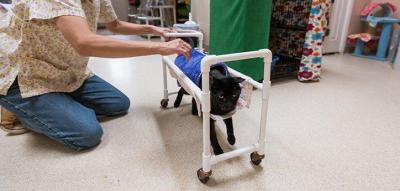
Cat Wheelchairs and Carts: What You Need to Know
Cats with mobility issues can benefit from cat wheelchairs or carts. The use of these devices can help a cat who has difficulties walking on their own to lead a happy and active life. Here are some frequently asked questions about cat wheelchairs.
What is a cat wheelchair?
A cat wheelchair is a device that assists cats with mobility issues. These extremely light carts, which strap on to the cat’s body and provide support, can enable a cat with front or back leg issues to become mobile. Carts allow these cats to walk, run, play, exercise, and sometimes even lie down, depending on the model.
What type of mobility issues are aided by cat carts?
Certain heart conditions, paralysis, cerebellar hypoplasia, congenital spinal or limb issues, injuries, or other disabilities can leave cats without fully functional limbs. Many times, these cats might otherwise be healthy and able to lead happy, pain-free lives.
Who determines whether a cat needs a wheelchair?
You should work with a veterinarian to determine whether a cat wheelchair would be beneficial for your feline. Cats have a keen sense of balance, so some can adjust to an injury or amputated limb and regain some level of mobility on their own. But those who are paralyzed or have difficulty relearning how to walk might be ideal candidates for a cat wheelchair.
Home starts with you
Are there different types of carts for cats?
The type of cart your cat will need is based on what type of disability they have. Carts for cats typically feature two harnesses: one that supports the cat’s shoulders and another that supports the cat’s hips or pelvic region.
Carts need to be custom-fitted according to your cat’s specific measurements and needs. Cats with front limb issues, weakness in all four legs, or cerebellar hypoplasia will typically need a four-wheel, or quad, cat wheelchair. Cart models that help with hindquarter issues have two wheels that are positioned on either side of where the hind paws would normally make contact with the ground. Different wheel types are used on the carts, depending on the terrain or soil type where they will be used.
Do cats have difficulty becoming accustomed to a wheelchair?
Most cats relish the freedom that a cart provides, so it usually takes only a few days for a cat to adjust. In some cases, it takes a bit longer, and some training and playful persuasion might be necessary to help your cat adjust. Whether your cat will be able to adapt to a cart might depend on their personality — e.g., whether they’re outgoing and interested in trying new things.
What accommodations for the cart can I make in my home?
Try to keep floor space and pathways as clear and open as possible. If your home has a lot of obstacles to navigate, the cart could get stuck frequently. Also, if you have stairs in your home, you might want to block them with a baby gate so that the cat doesn’t fall down the stairs with the cart on.
Should I leave my cat unattended in the cart?
Your cat should never be left unattended while in the cart. There’s a chance that the cart could become stuck or tip over. Also, your cat might enjoy the freedom of being outside in the cart, but they must always be supervised when outdoors. You can try walking your cat outdoors on a harness and leash.
How long should my cat be left in the wheelchair?
A well-made cat wheelchair allows your pet to move around the house or outdoors with ease. However, these carts are not made to be worn continually. Cats tend to spend a lot of time napping during the day, so you should remove the cart and harness during nap time for comfort and because sores can develop on contact points. Although a well-fitted cart should not cause soreness, you will need to carefully monitor your cat for signs of sores or abrasions.
